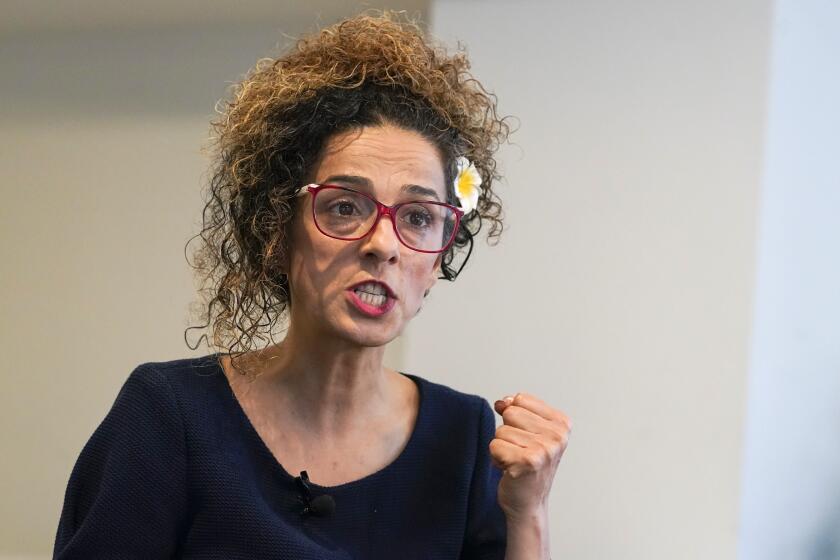An Italian journalist is freed from detention in Iran and returns home

- Share via
ROME — An Italian journalist detained in Iran for three weeks was freed Wednesday and returned home, after her fate had become intertwined with that of an Iranian engineer arrested in Italy and wanted by the United States.
A plane carrying Cecilia Sala, 29, landed at Rome’s Ciampino airport, where Premier Giorgia Meloni was on hand to welcome her alongside Sala’s family members. Sala’s companion, Daniele Raineri, posted a photo of a smiling Sala greeting Meloni in the airport.
Sala’s liberation marked a major diplomatic and political victory for Meloni, whose recent visit to President-elect Donald Trump at his Mar-a-Lago retreat greatly enhanced her stature internationally at a time when Italy was negotiating Sala’s release.
In announcing that Sala was flying home, Meloni’s office said the premier had personally informed Sala’s parents and credited the release to the government’s “intensive work on diplomatic and intelligence channels.”
Cecilia Sala, a reporter for the Il Foglio daily newspaper, was detained in Tehran on Dec. 19, six days after she arrived on a journalist’s visa.
Iranian media acknowledged the journalist’s release, citing only the foreign reports. Iranian officials offered no immediate comment.
Sala, a reporter for the Il Foglio daily, was detained in Tehran on Dec. 19, three days after she arrived on a journalist visa. She was accused of violating the laws of the Islamic Republic, the official IRNA news agency said.
Italian commentators had speculated that Iran detained and held Sala as a bargaining chip to ensure the release in Italy of Mohammad Abedini, who was arrested by Italian authorities at Milan’s Malpensa airport three days before, on Dec. 16, on a U.S. warrant.
The U.S. Justice Department has accused Abedini and another Iranian of supplying the drone technology to Iran that was used in a January 2024 attack on a U.S. outpost in Jordan that killed three American troops.
Abedini remains in detention in Italy but has asked a Milan court to grant him house arrest pending an extradition hearing.
An Iranian American journalist who once worked for a U.S. government-funded broadcaster is believed to have been detained by Iran for months now.
Sala’s release was met with cheers in Italy, where her plight had dominated headlines, with lawmakers from across the political spectrum praising the outcome and the opposition Democratic leader Elly Schlein thanking the government specifically.
It came after Meloni made a surprise trip to Florida last weekend to meet Trump at his Mar-a-Lago estate.
Meloni in a statement on X thanked “all those who helped make Cecilia’s return possible, allowing her to re-embrace her family and colleagues.”
Meloni’s visit to Trump had a strong impact on the premier’s international standing, which strengthened Italy’s hand in negotiations, Defense Minister Guido Crosetto said.
“Any time you can reinforce the credibility of a leader of a country at a particular moment, the stronger the country is,” he told Italy’s Sky Tg24.
Sala’s fate had become intertwined with that of Abedini. Each country’s foreign ministry summoned the other’s ambassador to demand the prisoner’s release and decent detention conditions. The diplomatic tangle was particularly complicated for Italy, which is a historic ally of Washington but maintains good relations with Tehran.
The Iranian activist and journalist has been living in exile in New York. Her identity is not in court papers, but she confirmed she was the intended target.
Members of Meloni’s cabinet took personal interest in the case given the geopolitical implications. Foreign Minister Antonio Tanaji and Crosetto hailed the diplomatic teamwork involved to secure Sala’s release.
But the release also posed a delicate political question for Italy given Abedini’s status. The United States has complained in the past when Italy has lost track of suspects in the Italian judicial system awaiting hearings for extradition to the U.S.
A hearing on his bid to be given house arrest is scheduled for Jan. 15.
Advocacy group Reporters Without Borders, which had flagged Sala’s detention as an attack on press freedom, cheered her release.
“Now the 25 journalists still held in Iranian prisons must also be released,” the group said in a social media post.
A campaign on Mohammadi’s behalf said she would be free for 21 days, but would have to serve the remaining prison time later.
Since the 1979 U.S. Embassy crisis, which saw dozens of hostages released after 444 days in captivity, Iran has used prisoners with Western ties as bargaining chips in negotiations.
In September 2023, five Americans detained for years in Iran were freed in exchange for five Iranians in U.S. custody and for $6 billion in frozen Iranian assets to be released by South Korea.
Western journalists have been held in the past. Roxana Saberi, an American journalist, was detained by Iran in 2009 for around 100 days before being released.
Also detained by Iran was Washington Post journalist Jason Rezaian, who was held for more than 540 days before being released in 2016 in a prisoner swap between Iran and the U.S.
Both cases involved Iran making false espionage accusations in closed-door hearings.
Winfield writes for the Associated Press.
More to Read
Sign up for Essential California
The most important California stories and recommendations in your inbox every morning.
You may occasionally receive promotional content from the Los Angeles Times.














